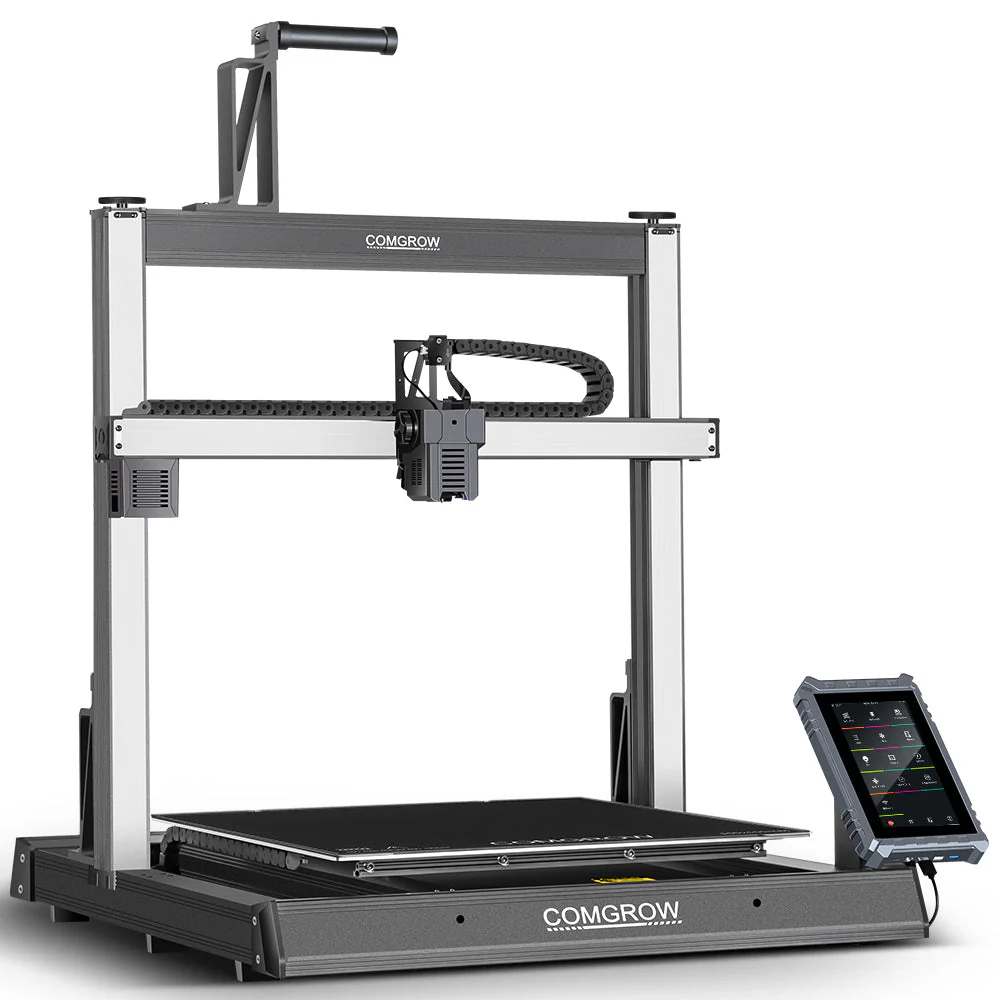Compare Comgrow T500 vs K1 Max
Comparison between the best 3D printers
Choose the best 3D printer at the best price. The cheapest 3D printers are here.
Buy a 3D printer here with 3D Fila.
 |
 |
|
| Model | Comgrow T500 |
K1 Max[BUY K1 Max] |
| Printing Material | Filament | Filament |
| Buy Filament for Sovol Comgrow T500 | Buy Filament forCreality 3D K1 Max | |
| Estimated price | $799,00 | $1300,00 |
| Manufacturer | Sovol | Creality 3D |
| Release Year | 2024 | 2023 |
| Print Volume [mm] | 500x500x500 | 300x300x300 |
| Printer Size [mm] | 817x810x962 | 435x462x526 |
| Weight [kg] | 39 | 18 |
| Power Loss Recovery | YES | YES |
| Enclosed printer | NO | YES |
| Bed Leveling | Automatic | Automatic |
| Filament End Sensor | YES | YES |
| Bed type | Heated | Heated |
| Power supply system | Direct Drive | Direct Drive |
| Standard nozzle | 0,4 | 0,4 |
| Maximum Nozzle Temperature [°C] | 300 | 300 |
| Maximum Bed Temperature [°C] | 80 | 100 |
| Maximum printing speed [mm/s] | 500 | 600 |
| Filament holder | YES | YES |
| Camera for supervision | NO | NO |
| Recommended filaments | PLA, PETG, Fibra de Carbono, TPU | ABS, PLA, PETG, TPU, PA, ASA, PC, PLA-CF, PA-CF, PET-CF |
| Recommended slicers | Creality Print, Cura 5.0 ou superior, Prusa Slicer, Orca | Creality Print, Cura, Simplify, Slic3r, IdeaMaker e outros |
| Maximum Resolution [mm] | 0,1 | 0,1 |
| Processor | ||
| Display | 7'' IPS touchscreen, 60Hz | Display touchscreen 4,3'' |
| Power Supply | 500 W | |
| Connectivity | USB / Wi-Fi / Ethernet | |
| Operating systems | Windows, Mac, Linux | |
| Date of registration in the system | 2024-07-18 | 2023-12-01 |
| Release date | 2024 | 2023 |
| Extra features | The Sovol Comgrow T500 stands out for its large print volume of 500x500x500 mm, ideal for large-scale projects. It has a direct extruder with a gear ratio of 6.5:1, speeds of up to 200 mm/s, and high-performance motors. The 7" touchscreen with Klipper software makes navigation easy. The 49-point automatic leveling ensures a perfect first layer. It also has a full metal hotend at 300°C, linear rails on all axes, and WiFi connectivity. | The Creality K1 Max stands out as a fast Core XY 3D printer with a large build volume of 300 x 300 x 300 mm. It is fully enclosed and equipped with AI sensors to prevent print failures. This model has a smooth and flexible PEI build platform, and uses an automatic leveling system with LIDAR, as well as a filament run-out sensor. LAN, Creality Cloud and USB Flash Disk connectivity are available, as well as a 4.3-inch touchscreen interface. The K1 Max is robust, weighing in at 18 kg, and includes an AI camera and limited version of the Klipper firmware. Its motion system is solid and the printer is efficient with high-temperature filaments, but it is not silent. Assembly is 99% complete, requiring only minor adjustments before use. |
| Support for multiple colors and materials (AMS and CFS) | NO | NO |
Notes * |
||
| Cost-benefit | 7 / 10 | 7 / 10 |
| Hardware | 3.6 / 10 | 4.8 / 10 |
| Tela | . | . |
| Print volume | 5 / 10 | 4 / 10 |
| Performance | 4 / 10 | 5 / 10 |
| [BUY K1 Max] |
Conclusion |
| In conclusion, the choice between the Comgrow T500 and the K1 Max largely depends on your specific needs and printing requirements. The Comgrow T500 offers a significantly larger print volume, making it ideal for larger projects, along with a user-friendly interface and extensive compatibility with a variety of filaments. Its advanced features such as 49-point automatic leveling and robust construction further enhance its appeal, particularly for users focusing on detailed work and versatility. On the other hand, the K1 Max, while it has a smaller print volume, excels in speed and efficiency due to its Core XY design and high maximum printing speeds. The fully enclosed setup is advantageous for printing with high-temperature materials, and its AI-assisted features provide added reliability during print jobs. However, potential users should note that it is heavier and more robust, and might not be as easily portable. When considering price, the Comgrow T500 presents a more budget-friendly option without compromising essential features, making it a great choice for hobbyists and those starting in 3D printing. Conversely, the K1 Max, being a higher-end model, is suited for professionals who prioritize speed and advanced technology in their workflow. Ultimately, both printers rate similarly in terms of cost-benefit, but the decision should rest on what attributes are most critical to you—whether enhanced volume and versatility or speed and advanced features take precedence. |

